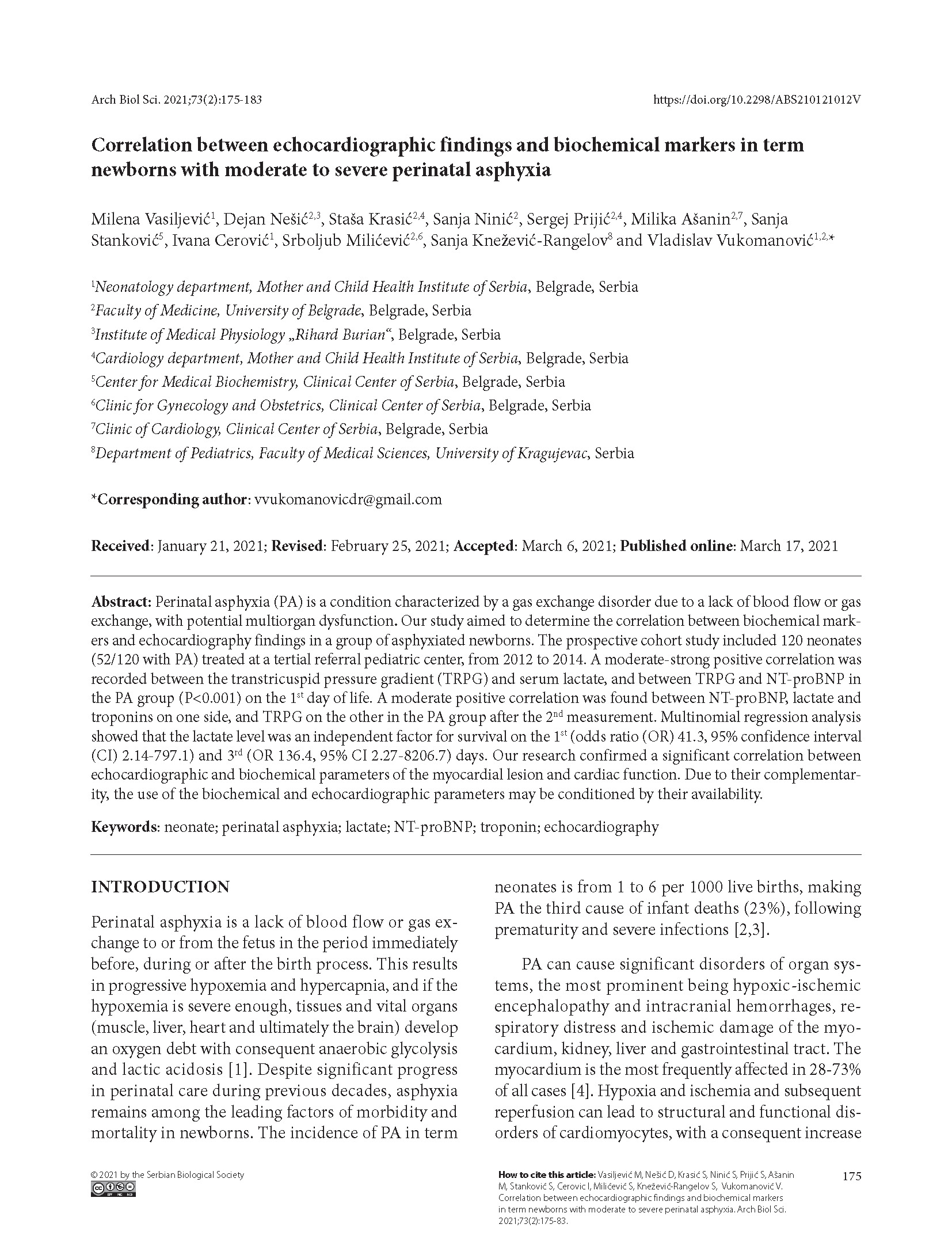Correlation between echocardiographic findings and biochemical markers in term newborns with moderate to severe perinatal asphyxia
DOI:
https://doi.org/10.2298/ABS210121012VKeywords:
neonate, perinatal asphyxia, lactate, NT-proBNP, troponin, echocardiographyAbstract
Paper description:
- Perinatal asphyxia is a condition characterized by a gas exchange disorder with potential multiorgan dysfunction due to a lack of blood flow or gas exchange.
- We determined the correlation between biochemical markers and echocardiography findings in asphyxiated neonates in comparison with control individuals.
- We confirmed a significant correlation between echocardiographic and biochemical parameters of the myocardial lesion and cardiac function.
- Due to their complementarity, the use of the biochemical and echocardiographic parameters may be conditioned by their availability.
Abstract: Perinatal asphyxia (PA) is a condition characterized by a gas exchange disorder due to a lack of blood flow or gas exchange, with potential multiorgan dysfunction. Our study aimed to determine the correlation between biochemical markers and echocardiography findings in a group of asphyxiated newborns. The prospective cohort study included 120 neonates (52/120 with PA) treated at a tertial referral pediatric center, from 2012 to 2014. A moderate-strong positive correlation was recorded between the transtricuspid pressure gradient (TRPG) and serum lactate, and between TRPG and NT-proBNP in the PA group (P<0.001) on the 1st day of life. A moderate positive correlation was found between NT-proBNP, lactate and troponins on one side, and TRPG on the other in the PA group after the 2nd measurement. Multinomial regression analysis showed that the lactate level was an independent factor for survival on the 1st (odds ratio (OR) 41.3, 95% confidence interval (CI) 2.14-797.1) and 3rd (OR 136.4, 95% CI 2.27-8206.7) days. Our research confirmed a significant correlation between echocardiographic and biochemical parameters of the myocardial lesion and cardiac function. Due to their complementarity, the use of the biochemical and echocardiographic parameters may be conditioned by their availability.
Downloads
References
Antonucci R, Porcella A, Pilloni MD. Perinatal asphyxia in the term newborn. J Pediatr Neonat Individual Med. 2014;3(2):e030269. https://doi.org/10.7363/030269
Hakobyan M, Dijkman KP, Laroche S, Naulaers G, Rijken M, Steiner K, van Straaten HLM, Swarte RMC, Ter Horst HJ, Zecic A, Zonnenberg IA, Groenendaal F. Outcome of Infants with Therapeutic Hypothermia after Perinatal Asphyxia and Early-Onset Sepsis. Neonatology. 2019;115(2):127-33. https://doi.org/10.1159/000493358
De Haan M, Wyatt JS, Roth S, Gadian D, Mishkin M. Brain and cognitive-behavioral development after asphyxia at term birth. Developmental Science. 2006;9(4):350-8. https://doi.org/10.1111/j.1467-7687.2006.00499.x
Jiang L, Li Y, Zhang Z, Lin L, Liu X. Use of high-sensitivity cardiac troponin I levels for early diagnosis of myocardial injury after neonatal asphyxia. J Int Med Res. 2019;47(7):3234-42. https://doi.org/10.1177/0300060519831187
hahidi M, Evazi G, Afkhamzadeh A. Echocardiographic evaluation of cardiovascular complications after birth asphyxia in term neonates. Pak J Med Sci. 2017;33(5):1220-4. https://doi.org/10.12669/pjms.335.12849
Sahni M, Jain S. Hypotension in Neonates. NeoReviews. 2016;17(10):e579-89. https://doi.org/10.1542/neo.17-10-e579
Jayaprasad N. Heart Failure in Children. Heart Views. 2016;17(3):92-9. https://doi.org/10.4103/1995-705X.192556
Taylor SA, Whitington PF. Neonatal acute liver failure. Liver Transpl. 2016;22(5):677-85. https://doi.org/10.1002/lt.24433
Edwards MO, Kotecha SJ, Kotecha S. Respiratory distress of the term newborn infant. Paediatr Respir Rev. 2013;14(1):29-36. https://doi.org/10.1016/j.prrv.2012.02.002
Masson S, Latini R, Anand IS, Vago T, Angelici L, Barlera S, Missov ED, Clerico A, Tognoni G, Cohn JN; Val-HeFT Investigators. Direct comparison of B-type natriuretic peptide (BNP) and amino-terminal proBNP in a large population of patients with chronic and symptomatic heart failure: the Valsartan Heart Failure (Val-HeFT) data. Clin Chem. 2006;52(8):1528-38. https://doi.org/10.1373/clinchem.2006.069575
Zhu R, Nie Z. A clinical study of the N-terminal pro-brain natriuretic peptide in myocardial injury after neonatal asphyxia. Pediatr Neonatol. 2016;57:133-9. https://doi.org/10.1016/j.pedneo.2015.08.001
Chen CA. Diagnostic Role of B-Type Natriuretic Peptide in Clinical Myocardial Injury Related to Neonatal Asphyxia. Pediatr Neonatol. 2016;57(2):87-8. https://doi.org/10.1016/j.pedneo.2016.02.001
Koch AM, Rauh S, Zink S, Singer H. Decreasing ratio of plasma N -terminal-pro-B-type natriuretic peptide and B-type natriuretic according to age. Acta Paediatr. 2006;95:805. https://doi.org/10.1080/08035250500466647
McKie PM, Burnett JC Jr. NT-proBNP: The gold standard biomarker in heart failure. J Am Coll Cardiol. 2016;68(22):2437-9. https://doi.org/10.1016/j.jacc.2016.10.001
Reynolds EW, Vranicar M, Bada HS. Recombinant human B-Type natriuretic peptide for persistent pulmonary hypertension. Pediatrics. 2004;114(5):1297-304. https://doi.org/10.2310/6650.2005.x0008.116
Vijlbrief DC, Benders MJ, Kemperman H, van Bel F, de Vries WB. Cardiac biomarkers as indicators of hemodynamic adaptation during postasphyxial hypothermia treatment. Neonatology. 2012;102:243e8. https://doi.org/10.1159/000339117
Teixeira R, Neves A, Guimarães H. Cardiac biomarkers in neonatology: BNP/NTproBNP, troponin I/T, CK-MB and myoglobin – a systematic review. J Pediatr Neonat Individual Med. 2017;6(2):e060219. https://doi.org/10.7363/060219
Costa S, Zecca E, De Rosa G, De Luca D, Barbato G, Pardeo M, Romagnoli C. Is serum troponin T a useful marker of myocardial damage in newborn infants with perinatal asphyxia? Acta Paediatr. 2007;96(2):181-4. https://doi.org/10.1111/j.1651-2227.2007.00104.x
Gouda M, Hammda B, Amen M. Short-term prognostic value of serum cardiac troponin I levels in neonates with perinatal asphyxia. Alex J Pediatr. 2017;30:108-19. https://doi.org/10.4103/ajop.ajop_3_18
Pandrc MS, Ristić A, Kostovski V, Milin-Lazović J, Milić N, Ćirić J. The role of echocardiography in monitoring the therapeutic effect of levothyroxine replacement therapy in subclinical hypothyroidism. Arch Biol Sci. 2020;72(1):137-46. https://doi.org/10.2298/abs191029007p
Eriksen VR, Trautner S, Hahn GH, Greisen G. Lactate acidosis and cardiac output during initial therapeutic cooling in asphyxiated newborn infants. PLoS ONE. 2019;14(3):e0213537. https://doi.org/10.1371/journal.pone.0213537
Kraut J, Madias N. Lactic acidosis. N Engl J Med. 2014;371:2309-19. https://doi.org/10.1056/NEJMra1309483
Geoffrey C, Aiken A, Bardgett RJM. Neonatal blood gases and outcome following perinatal asphyxia. Indian J Neonat Med Res. 2013;1:1-4.
Simović AM, Knezević J, Igrutinović Z, Stojanović N, Kocić S. Cardiac troponin as biochemical marker of perinatal asphyxia and hypoxic myocardial injury. Vojnosanit Pregl. 2009;66(11):881-6. https://doi.org/10.2298/vsp0911881s
Shadique AM, Sailavasan M. A prospective study on cardiac changes (electrocardiographic, enzymatic and echocardiographic) in birth asphyxiated neonates admitted in tertiary care centre. Int J Contemp Pediatr. 2019;6:269-74. https://doi.org/10.18203/2349-3291.ijcp20190547
Hayward CS, Kelly RP, Macdonald PS. Inhaled nitric oxide in cardiology practice. Cardiovasc Res. 1999;43:628-38. https://doi.org/10.1016/s0008-6363(99)00114-5

Downloads
Published
How to Cite
Issue
Section
License
Copyright (c) 2021 Archives of Biological Sciences

This work is licensed under a Creative Commons Attribution-NonCommercial-NoDerivatives 4.0 International License.
Authors grant the journal right of first publication with the work simultaneously licensed under a Creative Commons Attribution 4.0 International License that allows others to share the work with an acknowledgment of the work’s authorship and initial publication in this journal.



